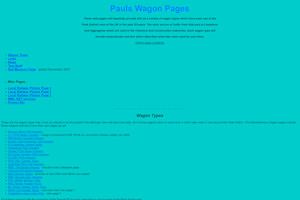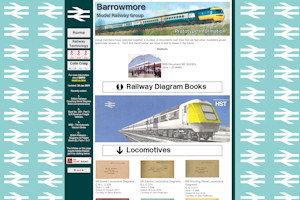LTSV >
Rail Data >
More >
Links - Other Sites
This page provides links to some other websites that may be of interest. I will be adding more over time but, if you have a suggestion for a site to include, please get in touch.
The links will be checked from time to time, but websites can disappear or be changed. Please let me know if you find a link that needs amending or removing.
 Pauls Wagon Pages
Pauls Wagon Pages
This small but interesting website detailed the types of wagons to be seen at Peak Forest, including such types as the famous ICI bogie hoppers, Buxton Lime JGAs and Brunner Mond JEAs. There is a page for each type with some (small) photos and background information. Unfortunately, the site has not been updated since 2007, and the photos on a couple of pages do not show.
 Rail Photo Archive
Rail Photo Archive
At last, a photo collection that is not on Flickr or SmugMug! The RPA presents a somewhat cluttered facade but there is some sensible organisation. However, if you click (for example) on 1st Gen DMUs, you get a list of class codes with no indication of what photos there are. Clicking on a class merely brings up a list of numbers. Although not immediately apparent, the underlined numbers have photos, though these can only be viewed quite small. There are a lot of old (eg 1980s) photos here so it might be worth persisting with.
Data sitesThese are websites that go beyond just photos to provide some information about the numbers or classification of rolling stock.
 Departmentals.com
Departmentals.comThis long-established website has extensive coverage of various departmental vehicles (excluding on-track plant, see below). Departmental coaching stock (and some wagons) are included, as are internal users. There are lots of photos, sightings and comments about individual vehicles, though you need to register for an account (which is free) to view some parts.
 Ontrackplant.com
Ontrackplant.com
Related to departmentals.com and equally long-established, this website specialises in the huge variety of track maintenance machines in the UK. Coverage includes current, historical and preserved vehicles, and there is also a lot of information about the smaller items (such as trolleys and road-rail machines) which were not covered by CEPS but which are now allocated individual EVNs. The information is in the form of photos, sightings and comments, and registering for a free account is required in order to see some parts.
 Railway Heritage Register On-Line
Railway Heritage Register On-Line
This website offers a huge amount of information about preserved rolling-stock. From the first screen you can select 'Carriage Survey', 'Wagon Survey' or various other options. You are then taken to a form where you can specify filters (such as the type, operator or builder), and then you get to the lists. There are limited sorting options (e.g. you cannot sort by numbers), and the results are shown as a list of links. But there are a lot, the unfiltered wagons list containing 10,993 items. Clicking on any individual link brings you to a page about that vehicle, with lots of information and often a photo or two.
 Blood and Custard
Blood and Custard
This is a very varied site, with lots of content, primarily connected to the Southern Railway/Region. Perhaps the best sections (from my perspective) are those looking at multiple units. These contain a wealth of detailed information, including technical and operational details, photos, formations, dates of operation, liveries, renumberings and disposals. Most classes of Southern unit are covered (or planned to be covered) and the pages are a nice mixture of narrative text and tabulated data.
 BR Database
BR Database
Sub-titled as a 'Complete British Locomotive Database 1923-1997', there is a huge amount of information on this website. A lot of the pages are tabbed. For example, you could use the main menu to select LNER Steam Locos of 1923-1947 design. From the resulting class list, you could pick J39. The main summary for this class is then shown, along with 11 other tabs. Clicking on the Fleet tab brings up a list of individual numbers. Clicking on a number brings up the detail page, with details of all known numbers, allocations, modifications, works visits and disposal. Fantastic for steam and pre-privatisation locos, there is also some info on multiple-units, though some pages seem to be missing. For example, picking any type of EMU from the side menu results in a blank page.
 Rail UK - British Railways 1823 - 2014
Rail UK - British Railways 1823 - 2014
Billing itself as the 'Premier UK Rail History Site', there is a lot of information here, though finding it is not particularly straightforward. You can search for any particular number, and you get results that are similar (though not as detailed) to those on BRinfo. However, as with that site, coverage of things other than locos is suggested but patchy. For example, if you search for 303001 it says three units were found (meaning three coach numbers). But all of the onward links end on blank pages. Likewise, if you search for 41001, it says '1 coaches found', but there is no info as to which one (the Mk1 suburban or the Mk3 HST trailer?) and no links to anything further.
 The 47s - Brush Sulzer Type 4
The 47s - Brush Sulzer Type 4
Limiting yourself to a particular class of rolling stock means you have more chance of providing comprehensive coverage, and this site does achieve that. As with many of these sites, finding stuff is not hugely straightforward, but you should soon be able to view histories for any given 'Duff'. The photo gallery is also pretty good, though again a bit convoluted. There are dozens of (smallish) photos of almost every individual class 47 loco.
 Railcar
Railcar
This site has masses of information about BR's first generation DMUs. Each type gets several different pages, covering topics such as numbering, liveries and operation in some detail. There are also diagram book pages, tons of photos and (somewhat hidden) the ability to see the full allocation and formation history of every single DMU car.
 The Railcar Association
The Railcar Association
Related to the Railcar website shown above, this site details the first generation DMUs that survived into preservation. You can see a list of all preserved DMU cars which looks fairly basic at first sight. But each number is a link to an individual page with a highly detailed overview of the car's post-BR career, including lots of photos.
 Barrowmore Model Railway Group - Prototype information
Barrowmore Model Railway Group - Prototype information
This website stands out for one section in particular - the prototype information page. Here you will find dozens of downloadable PDFs of scanned BR diagram books. The documents cover locos, coaches and most types of wagon, and many have hundreds of pages. A lot of the data on my website has been obtained from looking through these books.
Other sitesThe sites in this section are not specifically about railway photos or data, yet they can be useful and/or interesting.
 Goods and Not So Goods
Goods and Not So Goods
A curious name for a curious website, it is sub-titled 'An overview of railway freight operations for modellers (from around 1830 to about 2010)'. There are numerous pages on diverse topics such as track, signalling, liveries, goods facilities and loads, as well as on wagons themselves. The pages are mainly text-based, with lots of small diagrams and photos (mainly of models).
 RealtimeTrains
RealtimeTrains
This website has two distinct layers. The first is like a train-running app, as used by 'Joe Ordinary' for passenger train information. However, if you go to the detailed/advanced option, you can also see information on freight trains. The site also works well on mobile devices, and I have made much use of it while out photographing wagons.
 Open Train Times
Open Train Times
Somewhat similar to Realtime Trains, this website's original USP was the inclusion of live signalling diagrams (Kings Cross is shown on the screengrab here). Clicking on any train would bring up the details of the working.
 Freightmaster Online
Freightmaster Online
Back in the day, a Freightmaster book was virtually the only way to find and identify freight trains. There was later a website, with timetables and a forum. Publication of the timetable books has now ceased, so if you want to use Freightmaster you will need to pay for a subscription to the website. I haven't bothered renewing recently so I can't show anything but the home page. However, the last time I was in there was an increasing amount of live train running information, while the forum was busy with lots of sightings, detailed wagon fleetlists and lots of background information.
 FlightRadar24
FlightRadar24
During the first COVID-19 lockdown, I rekindled a childhood interest in aircraft thanks to this amazing website. Basically 'Real Time Planes', you can see what is flying near you, where it came from and where its going, how fast, how high etc. And if you're a plane spotter, the aircraft type and registration is shown. Mainly civil, with some coverage of military flights, the basic website is free to use, though you can register for a paid account to get some extra bells and whistles.
 Pocketmags
Pocketmags
There are still lots of magazines devoted to railways, or particular aspects of railways (as well as to every other subject under the sun of course). Digital subscriptions can save you money, are probably more environmentally-friendly, and certainly more postman-friendly. There are various sites offering on-line magazines, but I have found Pocketmags to be pretty good. Most (but not all) of the major railway titles are available here.

 Register
Register
 Pauls Wagon Pages
Pauls Wagon Pages
 Rail Photo Archive
Rail Photo Archive
 Departmentals.com
Departmentals.com Ontrackplant.com
Ontrackplant.com
 Railway Heritage Register On-Line
Railway Heritage Register On-Line
 Blood and Custard
Blood and Custard
 BR Database
BR Database
 Rail UK - British Railways 1823 - 2014
Rail UK - British Railways 1823 - 2014
 The 47s - Brush Sulzer Type 4
The 47s - Brush Sulzer Type 4
 Railcar
Railcar
 The Railcar Association
The Railcar Association
 Barrowmore Model Railway Group - Prototype information
Barrowmore Model Railway Group - Prototype information
 Goods and Not So Goods
Goods and Not So Goods
 RealtimeTrains
RealtimeTrains
 Open Train Times
Open Train Times
 Freightmaster Online
Freightmaster Online
 FlightRadar24
FlightRadar24
 Pocketmags
Pocketmags